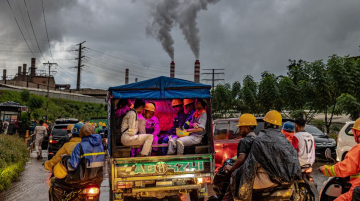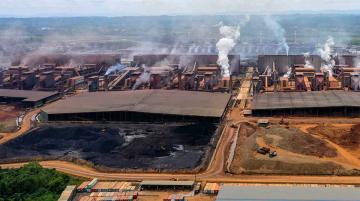
The deafening roar of bulldozers ripped through the tranquil forest near nickel smelting, scattering birds and shattering the harmony that had defined O Hongana Manyawa’s home for generations.
In November 2023, a viral video captured two men from this nomadic tribe standing defiantly in front of the machines tearing through their land, armed only with wooden sticks.
Their gestures to halt the destruction were ignored, and the roaring engines forced them to retreat.
“The mine is getting closer to our village every day, so naturally, the areas for hunting are becoming further and further away,” laments Mardon ‘Don’ Saolat, his voice tinged with frustration and sorrow.
This act of resistance is emblematic of a much larger struggle. The O Hongana Manyawa, a resilient hunter-gatherer community on Halmahera Island in North Maluku, is fighting not just to protect their ancestral land but to preserve their very way of life.
Their story highlights a larger global tension between progress and preservation, challenging the ethics of so-called “sustainable” technology.
Understanding Halmahera Island and the Nickel Conflict

Halmahera is an island located in the North Maluku province of Indonesia, part of the sprawling archipelago that stretches across Southeast Asia.
Known for its rich biodiversity and lush forests, Halmahera is home to the O Hongana Manyawa, a nomadic hunter-gatherer tribe whose name translates to “people who live in/from the forest,” reflecting their deep connection to the land.
These people live in harmony with their environment, relying on the forest’s resources for sustenance and shelter.
Indonesia is one of the largest producers of nickel, a metal essential to the production of electric vehicle (EV) batteries.
Nickel’s importance has surged alongside the global shift toward greener energy sources, as it plays a crucial role in powering electric vehicles and storing renewable energy.
As demand for nickel grows, regions like Halmahera have become hotspots for mining and nickel smelting activities, sparking a clash between economic development and the preservation of indigenous cultures.
The Indonesian government has heavily promoted mining projects, seeing them as a path to economic growth.
The Destruction Boom

Nickel exploration began after Strand Minerals, a subsidiary of Canada’s Weda Bay Minerals, identified an estimated 90 million dry tons of nickel in several areas of Halmahera.
Weda Bay Nickel (WBN), a company established in 1998 through partnerships with the French company Eramet and China’s Tsingshan, now holds a 30-year license covering 120,500 hectares of land, much of it overlapping with the O Hongana Manyawa’s traditional territories.
This project is part of Indonesia’s push for downstream processing in mineral industries. In 2014, the government banned raw ore exports, leading to the creation of the Indonesia Weda Bay Industrial Park (IWIP), in collaboration with Huayou Cobalt and other local companies.
Survival International has consistently warned about the harmful impact of nickel mining on the O Hongana Manyawa. They’ve urged the Indonesian government to protect the tribe’s rights and lands before further damage occurs, but the government has shown little specific concern for their plight.
A Way of Life Under Existential Threat






The O Hongana Manyawa’s way of life is deeply traditional, rooted in customs and practices handed down through generations. They balance using forest resources with conservation, constructing houses from wood and dried palm leaves in areas where they can hunt, fish, and gather essentials like firewood and medicinal plants.
“They call them ‘Togutil,’ which means ‘primitive’ or ‘stupid.’ That kind of language erases the dignity and depth of their culture,” explained Roem Topatimasang, an environmental researcher and advocate for indigenous rights.
They also possess local wisdom in managing natural resources and maintaining the environmental balance, reflected in their name, O Hongana Manyawa, which means “people who live in/from the forest.” Like the local knowledge of indigenous peoples all around the Earth, they use forest resources while also conserving them.
As a nomadic hunting and gathering group, they build bivouac houses with wooden walls and roofs made of dried palm leaves (Borassus flabellifer).
These bivouac houses are constructed in comfortable locations, usually between the forest and the river, where they can gather firewood, medicinal plants, cooking spices, and also hunt animals, fish, or sogili (river eels).
They still send messages using symbols made from woven materials and use woka leaves (Livistona) to make plates and cups.
Economic development has already forced some O Hongana Manyawa to move to villages like Dusun Titipa. In Indonesian social structure, Dusun is a sub-village, the smallest unit of a group of families.
The Story of Don
Don, one such individual who still relies heavily on the forest for gardening and hunting, said that mining operations and restrictive regulations have made these activities increasingly difficult.
Don is a direct descendant of the O Hongana Manyawa and has lived among the Tobelo Luar community in Dusun Titipa. Despite this, he remains familiar with the customs of the Tobelo Dalam and depends on forest resources for his livelihood.
He admits that since the introduction of mining, nickel smelting and hauling roads, “Our hunting areas keep moving further away,” he says, frustrated by shrinking spaces allocated for indigenous use.
Some members, like Don, have found themselves navigating hybrid identities. Born in the forest but now living in Dusun Titipa, Don is part of the Tobelo Luar community, a group adapting to life outside and beyond the forest.
Yet, his bond with the Tobelo Dalam, those deeply rooted in traditional ways, remains strong. “Even here, I rely on forest resources for gardening and hunting,” he says.
“On the edges of our village, there are the Forest Management Units,” Don continues. “The population keeps growing, but we’re only given a few hectares.”
A Global Ethical Dilemma






Tesla’s 2023 Impact Report brought global attention to Halmahera, advocating for the creation of “no-go zones” to protect indigenous territories from mining activities. However, the recommendations have received mixed reactions, with the Indonesian government remaining largely noncommittal and mining companies voicing concerns over potential operational constraints.
The proposal directly impacts projects like the Weda Bay Nickel mine, which operates on land overlapping the traditional territory of indigenous tribes, raising fears of irreversible environmental damage and displacement.
While Tesla does not source nickel directly from Weda Bay, critics argue that its supply chain remains indirectly linked to companies like Tsingshan. The company’s commitment to Free, Prior, and Informed Consent (FPIC) highlights a broader dilemma: how can such consent be obtained from uncontacted tribes like the O Hongana Manyawa?
The tension between progress and preservation stands at the heart of this unfolding narrative, challenging the future of “sustainable” technology. Nevertheless, no concrete steps are being taken by the mining company towards the indigenous community.
Resistance and Resilience






The Tobelo Luar indigenous community is also struggling to protect their rights to their customary forest from the pressures of government regulations through Forest Management Units and National Parks.
Government-imposed conservation laws, which often contradict customary practices, further marginalize communities. Don recounts being detained for farming and collecting wood in restricted areas, a reality many Indigenous people face as they navigate shrinking territories and mounting criminalization.
“Yesterday, I was detained, and I was called to the office. I was farming, you see. When we farm, we also collect wood. I cut wood into pieces and sell them to cover the costs. It’s indeed in the forest territory, but I have already said I am farming here,” said Don. Despite this, Don was soon released. According to him, the authorities were still “kind enough” to provide room for negotiation.
Criminalizing Don
The criminalization and human rights violations faced by Don are seen as ‘light’ compared to the cases of Bokum and Nuhu, two members of the O Hongana Manyawa who were accused of murder in Waci, Halmahera. These accusations arose amidst a complex regional conflict.
Both men were sentenced to 15 years in prison in 2014. Nuhu died from chronic back pain in 2019, while Bokum was released on January 24, 2022. He was escorted back to the Ake Jira Forest to reunite with his family by Syaiful Majid, a sociologist from Universitas Muhammadiyah Maluku Utara. To this day, direct evidence of their involvement in the murder remains unproven.
Similarly, Samuel Gebe and Alen Baikole were sentenced to 20 years in prison on September 15, 2023, by the Soasio District Court in Tidore Kepulauan, North Maluku. The charges stemmed from an attack on mining workers accused of violating sacred forest areas and customary laws.
The O Hongana Manyawa have been stigmatized as a dangerous group, which many believe is part of a deliberate effort by authorities or interested parties to justify expanding mining operations into their ancestral lands.
This struggle reflects a broader issue faced by Indigenous communities worldwide: navigating the rapid changes and impacts of modern industry.
“There’s an old man who doesn’t want to be evicted,” Don recalled. “He’s offered money but refuses. He says, ‘Oh, the government now… Back in Soeharto’s era, the [indigenous] community was allowed to farm, but the current leaders don’t want farming and want to evict us again. They say they’ll provide for the community, but in reality, they’ll make things difficult for us. It’s just about evicting us, using the iron fist.’
This article can be republished under the Creative Commons BY NC ND license.




